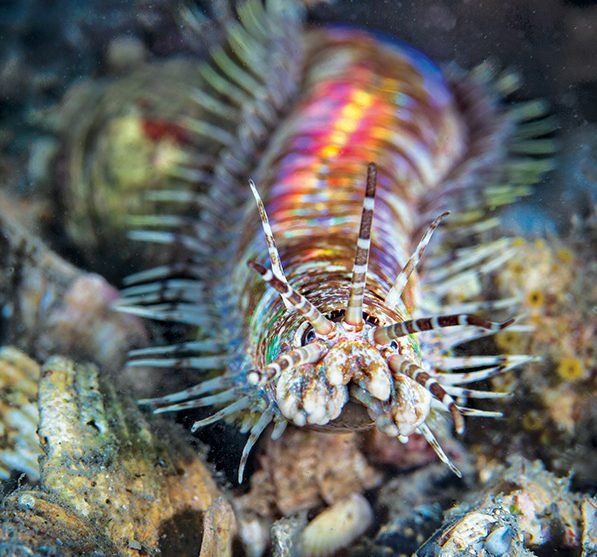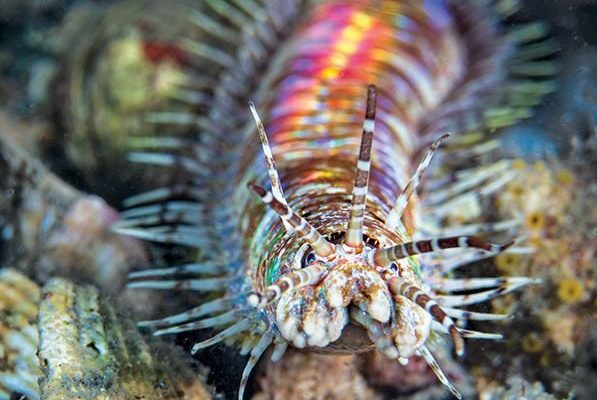
Understanding Bobbit Worms: An Overview
Bobbit worms, scientifically known as *Eunice aphroditois*, are remarkable marine creatures that can grow up to 10 feet long. They have a long, segmented body and a unique pair of jaws that are capable of snapping shut with incredible speed. This makes them highly effective predators, primarily hunting fish and crustaceans.
You might be wondering, where do these worms live? Bobbit worms prefer sandy or muddy substrates in warm waters. They burrow themselves in the sand, leaving only their colorful heads exposed, which can be quite mesmerizing to see. Their camouflage makes them tricky to spot, but with the right tools and techniques, you can witness these fascinating animals up close at night.
Why Use Red Light?
Here’s the thing: most marine animals are sensitive to bright white light. It can startle them, causing them to hide or swim away. Red light, on the other hand, is much less distressing. Many creatures can’t see in the red spectrum as well as in others, making it perfect for night observation.
Using red light allows you to observe Bobbit worms in their natural habitat without causing them unnecessary stress. You might feel like a special guest peeking into their secret life, rather than an intruder. Plus, red light also helps you maintain your night vision, so you can watch not just the worms, but any other nighttime marine activity around you.
Choosing the Right Red Light
When it comes to picking a red light for your night-time adventures, there are a few factors to consider:
- Type of Light: A red LED flashlight is a solid choice. They’re energy-efficient, long-lasting, and provide a bright beam.
- Size and Portability: You want something lightweight that’s easy to carry on your beach outings.
- Durability: Look for waterproof or water-resistant options since you’ll be near the ocean.
- Brightness Settings: A light with adjustable brightness can help you adapt to different viewing conditions.
Some popular options include the SureFire G2X Pro or the Streamlight ProTac, as they both offer reliable performance and a red filter option.
Getting Ready for Your Night Observations
Before you head out to observe Bobbit worms, it’s essential to prepare properly. Here’s a little checklist to ensure you’re ready:
1. **Choose the Right Location**: Look for areas with sandy or muddy bottoms where Bobbit worms are likely to reside. Tide pools or shallows can be great spots.
2. **Wait for Nightfall**: Bobbit worms are primarily nocturnal, so plan your excursion for after sunset.
3. **Gather Your Gear**: Besides your red flashlight, consider bringing a mesh net or a small container. This is helpful if you want to gently capture a moment or two of their behavior without causing harm.
4. **Bring a Friend**: Observing these spectacular creatures can be even more fun with a buddy. Plus, they can help you with the light, so you don’t miss anything!
How to Observe Without Disturbing
Now that you’re all set up, it’s time to start observing. Here’s how to do it without disturbing the delicate ecosystem:
1. **Approach Slowly**: When you’re near a suspected Bobbit worm, move carefully. Quick movements can cause them to retreat into their burrows.
2. **Use the Red Light Sparingly**: Shine your red flashlight gently over the area. Avoid shining directly into their hiding spots. Instead, cast light over the surrounding sand and rocks.
3. **Watch for Movement**: Pay attention to subtle movements or changes in the sand. If you’re lucky, you might see a Bobbit worm emerge to hunt or feed.
4. **Practice Patience**: Sometimes, it may take a while for the worms to come out, so be patient. Enjoy the other nighttime marine life around you while you wait, like crabs scuttling about or fish swimming near the shore.
What to Do If You Don’t See Any Bobbit Worms
It can be a bit disappointing if you don’t spot any Bobbit worms on your first attempt. But here’s the thing: don’t give up! These worms can be elusive, and many factors can influence whether you see them or not. Here’s how you can increase your chances:
- Try Different Times: Experiment with different times of the month or year. Tides and moon phases can affect their activity.
- Change Locations: If one spot doesn’t yield results, don’t hesitate to venture to another area.
- Share Your Experience: Join local marine observation groups. They can provide valuable tips and might even know of hotspots for Bobbit worms.
Respecting the Environment
While it’s exciting to watch Bobbit worms, it’s crucial to respect their habitat. **Never attempt to touch or disturb them**, as this can be very stressful for the creatures. Observing them from a distance is not only ethical but also ensures that the underwater ecosystem remains undisturbed.
Remember to clean up after yourself and be mindful of the environment. The ocean is a fragile place, and we must do our part to protect it.
Using red light to observe Bobbit worms at night can be a thrilling experience. It opens up a fascinating world that many people never get to see. Whether you’re a curious marine enthusiast or just looking for something unique to do under the stars, this method will surely pique your interest.
As you plan your next nighttime outing, take your time to enjoy the process. Connect with nature, appreciate the beauty around you, and remember—observing marine life can be just as exhilarating as any adventure on land. So grab your red flashlight, and get ready to dive into the underwater mysteries waiting just beneath the surface!

